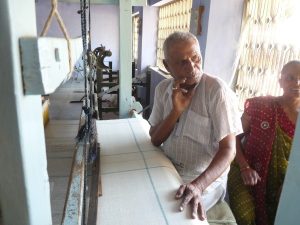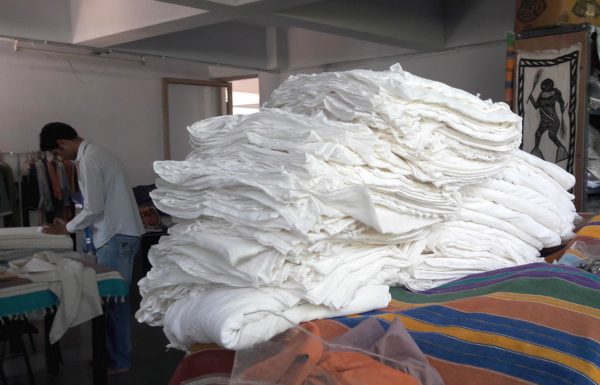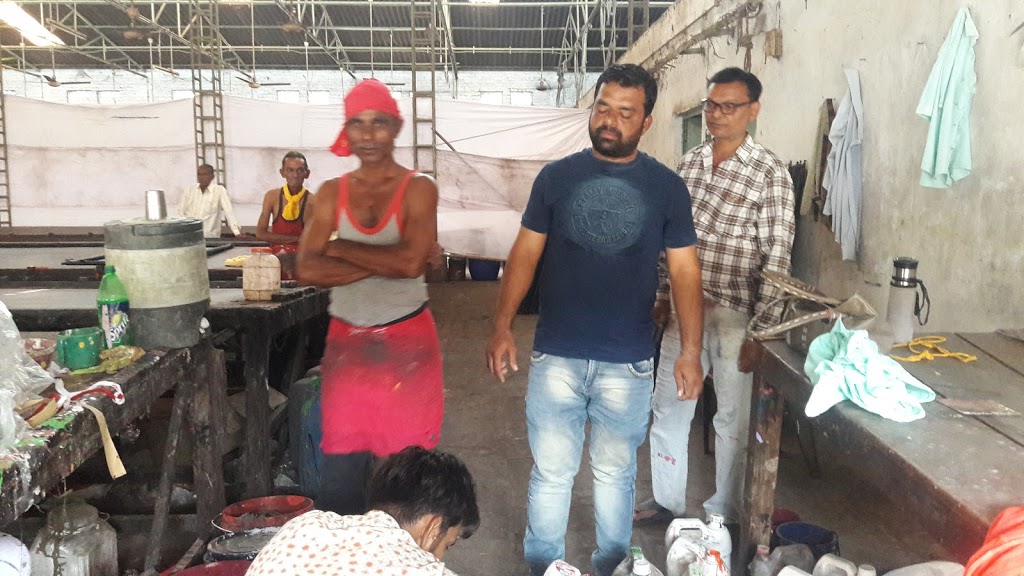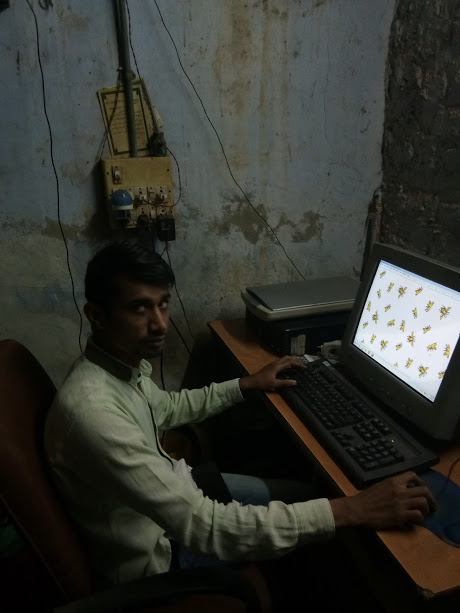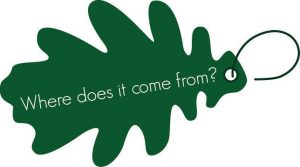Your Garment Stories
C25DD7W – The Story of your Preeti Flower Scarf
This is the story of your Preeti Flower Scarf
C: The Cotton for your Preeti Flower Scarf was grown in Gujarat, India
The seeds from all the cotton are removed – this process is called ginning. The fluffy cotton balls are now processed and turned into slivers. The slivers are then taken to the co-operative to be spun into yarn.
2. Spinning
My name is Meenaben. Kem chho?!
I have been one of the younger ones to spin yarns in our neighborhood.
My son is studying in 10th standard. We are planning for his future studies.
The co-op is good and fair. We are given the cotton by weight and the count of yarns we should spin. Any problem, they would help. When we go to the office, they check and double check the weight per kilo, the length of yarns we have spun and also the quality of yarns by conducting tests. They say “We are fair to you and also to the co-op! We are careful that there is no injustice to either party!!”
Meenaben works with two of her neighbours who have also been spinning cotton for Where Does It Come From? They also span the fabric for our last scarf production. They are part of a community which does not encourage women to go out to work, so they can spin from their home and earn money to supplement their family income.
5. The Weaver’s Story
My name is Kanubhai. Jay Mataji,
I am a weaver all my life and I come from weaver’s family! I am 72 years old. (It was unbelievable; he looks very fit and healthy!) I used to weave on my own but now I come to the co-op to help my daughter Monghiben!! It helps her and this keeps me busy. She is not here today so I am on my own here. We come here from a nearby village every day. Work is in my nature!! I work at my own will. I am not employed by anyone.
Weaving is all timework. A family of weavers is never free!! There are bobbins to fill, beems to roll, tie each end of the yarn, sizing the yarns and so on and on!! The mind is totally occupied. Arms, legs and the rest of the body are moving in a rhythm. At the end of the day the body aches but I have no diabetes, no blood pressure or other major illness. This kind of focused work with mind and body keeps me engaged. I am not sure it is yoga, prayer?! May be!
The cotton fabric is now ready for dyeing.
D – Design Development by MORALFIBRE
MORALFIBRE has been a production partner with Where Does It Come From? since the beginning! Together we have created many different ranges of clothes – from scarves to denim children’s garments. For our 2017 range of scarves we spent a long time working with the Where Does It Come From? team on new designs.
Design Development:
Jo and her team came up with design ideas. The Preeti Flower was designed by a young girl (Preeti) for her Dad. He pledged in our crowdfund in 2016 to have the design put onto a shirt. We loved the flower design so much that we asked their permission to make scarves with it too! Sanjay from MORALFIBRE then used the flower to create a scarf design. Here you can see the scarf design we came up with.
D- Dying the Fabric
I am Rafiqbhai. Kaise ho?!
I specialize in dying cotton fabrics. I am originally from Rajasthan and I have moved here for few years now. I work with my cousin Tahirbhai the printer. We come from chhipa community who have been traditionally known for the quality of our colours and print for genarations. I run my own small unit and we use the best possible dyes. “With my traditional knowledge and experience and learning new things, no one can beat me in color matching!”
Here are some of the scarf fabrics after dyeing.
7. Screen Printing
This is the first time Where Does It Come From? has used screen printing for our scarves. A lot more detail was possible compared with the block printing used for our previous scarf developments.
Once the designing of the scarf is completed by MORALFIBRE and agreed with WDICF, the perfect size drawings are prepared which would meet the special needs for screen printing. These designs are passed on to Tahirbhai the master printer. We have worked with Tahirbhai on a number of our productions.
His team of screen makers start work. First they copied the design to a special programme. In this video you can see Yasim converting the aqua bee design into the screens provided. There needs to be two separate screens made as that design has two colours and each colour is printed separately. For the Preeti Flower Scarf design only one screen is necessary as there is only one colour print.
The scarf designs are printed out to scale on special paper. This will be exposed and a screen will be prepared with fine holes where the design is. This will allow the dyes to pass through and the pattern gets printed on fabric. It is an amazing process!
Yasin has studied 12th standard (A level equivalent) and has then done a computer course. He has learnt this screen making programme in his first job and he has been working with the team for last three years. Many times he makes more than 50 screen designs in a day. He is probably the only one with computer skills so he is respected in the field. He is paid well too.
The printing frames are then created – here we can see Musabhai setting up the frames.
Here are the completed screens – you can see the holes through which the dyes can fit through to make the design on the fabric.
Tahirbhai, the master printer works with seven artisans, five of them are seen here. From L to R Nanjibhai, Kasimbhai, Ganubhai, Rahemanbhai and Babubhai. they all live within walking distance to the printing unit. It is fascinating to know that all of them have been printers all their lives and most of their life they have worked together as a team. They have worked for many different maser printers but they themselves worked in the same team. They are paid certain minimum wage and additional amount when they print more. They lay out and print 1500 meters fabric in a day. Each printing table is 30 meters long they work in a team of two on six different tables, one table at a time. needless to say, their synergy is very unique. They do not need to talk much while working. They understand and respond to one another beautifully. They are like a family, probably more than a family and they also enjoy their tea breaks together. They do not generally do small orders like ours so it was a great experience working with them.
Here they are hard at work printing our bee scarfs (red). The temperature in Gujarat was over 40 degrees at that time so they got up extra early and started work at 6.00am to work in a cooler temperature. Long tables are coated with wax to hold the fabric firmly in place while the different screens are laid on top. The dyes are then spread over the screens so the required colours can spread through the holes to make the design.
When the scarves are completed they are packed up by MORALFIBRE Fabrics, who oversee the printing process, and sent of to us at Where Does It Come From?
W – WHERE DOES IT COME FROM?
Hi I’m Jo, the founder of Where Does It Come From? – the clothing business that brings you ethical and traceable clothes. Currently based in Ipswich, Suffolk (UK) we work closely with socially focussed production partners. Together we create and develop the designs and produce beautiful clothes that harness the skills of the local artisans. We work as ethically and sustainably as possible to create beautiful basics that you will want to wear again and again. We hope that finding out about how your clothes were made and the people who made them will make you love them just a little bit more…..
From idea to business launch took two years, with launch happening in June 2014. You can read more in our News & Blog section, including newspaper and radio coverage. It’s been wonderful to be acknowledged for our work – 2016 named us as runner up in the ‘Greenest Product’ category at the Suffolk Green Awards as well as being selected as a Green 100 business – the top 100 ethical businesses in East Anglia. More recently we were delighted and honoured when Joanna Lumley wore one of our scarves on her TV documentary ‘Joanna Lumley’s India’.
Thank you so much for buying from us – the more we sell the more difference we can make. We have lots of plans for new designs, new partners and new projects so stick with us and together we can change the world!




